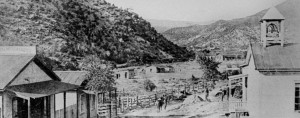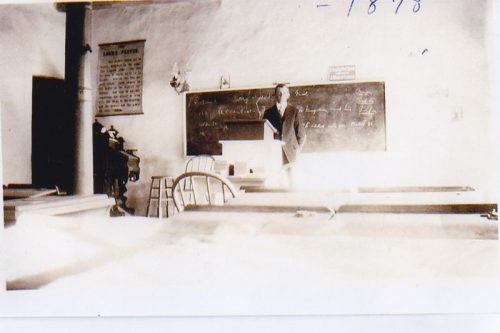
All old photos of the early days of Jemez Springs prominently feature the steeple of the Jemez Springs Community Presbyterian Church, which opened in 1881 as a school as well as church. As you can see from the photo above, not much else was there at that time. The story of this historic church started when Rev. J. M. Shields, a physician as well as a minister, came from Pennsylvania to Jemez Pueblo in 1878 to establish a mission. The Pueblo donated land for a building site at Walatowa (site of today’s Jemez Pueblo) on condition that it was the church’s as long as it was used for a mission. Later that year, Shields’ wife Emily died. The following year, the Women’s Board of Home Missions sent out two more missionaries: Lora B. Shields, a cousin, and Isabella Leach, whom Shields subsequently married.
In 1881, Rev. Shields moved to Jemez Springs to establish a church there. Jose Francisco Archuleta donated the land for the new church. J. M. Shields, J.W. Miller and Ematerio Archuleta were the first church trustees. The first mission teacher was Mary Harris. Other teacher/missionaries came later, including Jesse Lime Fenton, Clara Shurtleff, Mariette Wood and Mary Lodisa Stright.
Mary Stright’s journals create a picture of what life was like for a Pennsylvania girl set down amidst the exceedingly unfamiliar environment of a Southwest Indian pueblo in the 1800s. Her writing reflects prejudice against Indians, Mexicans and the Catholic Church. She left the Pueblo and in 1884 married John W. Miller, who owned the Santa Fe Stage Station and Jemez Trading Post. She began teaching in Jemez Springs and was active in the Jemez Springs Presbyterian Church for many decades, serving as elder and organist. John Miller died in 1916, and Mary continued to manage the businesses, which ultimately included a hotel, mercantile and restaurant. She died in 1947 and is buried in the cemetery in Jemez Springs.

The Jemez Springs Community Presbyterian Church celebrated its centennial — plus 18 years — in July 1999. A special issue of their newsletter, The Jemez Valley Messenger, included a timeline of church history and reminiscences of several congregation members who grew up here. Rev. Shields’s descendants retain property in the valley to this day.
The original adobe church is still there, surrounded by modern structures that were built over and around it. If you enter the lower level and go into the community room, you are standing in the 1880s church. Once a pot-bellied stove warmed the space, and the old organ and the few pews along the walls are from earlier days. Ed Brown, a lay leader who was a member in the late 40s and early 50s, wrote in the special edition the Messenger that
[t]he Church home was a one room adobe building with an old-fashioned wood burning stove in the middle of the room for heat. John Adams (Paul and John’s father) would have the stove cherry red hot by the time we arrived on cold winter days. Helen Adams (daughter of Dr. Shields) . . . would have the handmade pews, actually wood benches with backs, cleaned and the bare floors swept. She or one of our girls would play the foot-pumped reed organ while we sang old favorite hymns.
In an unsourced Historical Sketch of the Presbyterian Church and Mission, at Jemes [sic] Pueblo New Mexico, the proceedings of Sessions from 1877 to 1899 are recorded. Written in beautiful Copperplate handwriting, the document lists those baptized at the Jemez Springs and Jemez Pueblo churches. Reflecting the prejudice of the time, Shields’s letters complain about the difficulty of teaching Protestant Christianity to the Jemez Pueblo people. He is quoted in a research paper written by Richard Sanchez that “the Indians are under a deeper darkness and in worse condition. For many reasons, it is almost impossible to change Indian ways.” His efforts were hampered by lack of knowledge of both Towa and Spanish. In addition, Presbyterian missionaries throughout New Mexico were in competition for souls with the long-established Catholic Church. The two religions appear to have denigrated one another in a most un-Christian way. An example of this rivalry is explained in The Story of Presbyterian Work at Jemes [sic] 1920-1948 by Rev. Paul S. Berry, in which he describes at some length a contentious law suit between the two faiths regarding the church’s property at the Pueblo.
Rev. Berry served the church here and at the pueblo from 1920-1948. Apparently there had been no minister for several years prior. Around 1916, he had come to live in the Ministers’ Building of the Presbyterian Sanatorium in Albuquerque, presumably for treatment of tuberculosis. In 1918, he lived for six months at the ranch of J. B. Block north of Jemez Springs. He wrote that when he first moved to the Village of Jemez Springs,
. . . the church people invited me to live in the Church rooms. We fixed the roof to make it livable, but have been fixing the same roof ever since. I told them we should hold services if I were to occupy the rooms. They were willing; so the first service was held Thanksgiving Day, 1920. Then I was told that Jemes [sic] Pueblo belonged with Jemez Springs, so I walked down, swept the leaves and dirt out of the Chapel, and the following Sunday we began preaching there. After that I went once a month to Jemes, walking down and back except for occasional rides, because cars were just beginning to come to the Cañon.
The small rural church frequently had a difficult time finding a minister. Another example of how the problem was solved is recounted in a 1954 article in New Mexico Magazine, which described the experiences of student ministers:
It’s a church without a session (a governing body), nor has it deacons, deaconesses or elders. It’s a debt-free church. The congregation buys something for the mission if it has enough money saved from the small offerings. If there isn’t sufficient money, the purchase waits. And it’s a faction-free church.
 In 1981, a brochure was published with a brief history of the church and some historic photos. In 1989, a new sanctuary was dedicated after a major remodel. In recent years, the church has been served by a series of part-time ministers.
In 1981, a brochure was published with a brief history of the church and some historic photos. In 1989, a new sanctuary was dedicated after a major remodel. In recent years, the church has been served by a series of part-time ministers.
The church celebrated its 118th anniversary in 1999 with a special edition of their newsletter, The Jemez Valley Messenger. Excerpts from issues of the Jemez Valley Messenger in more recent years were shared from the church archives. Click on the date below to read about activities and accomplishments in these years: Jan/Feb 2004; Jan/Feb 2001.